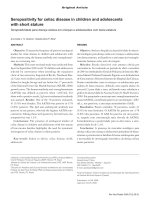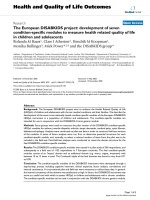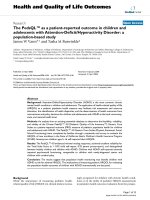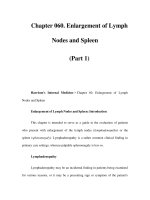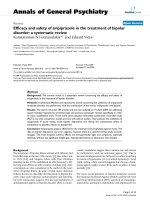TREATMENT OF BIPOLAR DISORDER IN CHILDREN AND ADOLESCENTS - PART 1 ppsx
Bạn đang xem bản rút gọn của tài liệu. Xem và tải ngay bản đầy đủ của tài liệu tại đây (652.85 KB, 43 trang )
TREATMENT OF BIPOLAR DISORDER
IN CHILDREN AND ADOLESCENTS
Treatment of Bipolar
Disorder in Children
and Adolescents
Edited by
B
ARBARA GELLER
MELISSA P. D ELBELLO
THE GUILFORD PRESS
New York London
© 2008 The Guilford Press
A Division of Guilford Publications, Inc.
72 Spring Street, New York, NY 10012
www.guilford.com
All rights reserved
No part of this book may be reproduced, translated, stored in
a retrieval system, or transmitted, in any form or by any means,
electronic, mechanical, photocopying, microfilming, recording,
or otherwise, without written permission from the Publisher.
Printed in the United States of America
This book is printed on acid-free paper.
Last digit is print number:987654321
The authors have checked with sources believed to be reliable in their efforts to provide information
that is complete and generally in accord with the standards of practice that are accepted at the time
of publication. However, in view of the possibility of human error or changes in medical sciences,
neither the authors, nor the editors and publisher, nor any other party who has been involved in the
preparation or publication of this work warrants that the information contained herein is in every
respect accurate or complete, and they are not responsible for any errors or omissions or the results
obtained from the use of such information. Readers are encouraged to confirm the information con-
tained in this book with other sources.
Library of Congress Cataloging-in-Publication Data
Treatment of bipolar disorder in children and adolescents / edited by Barbara Geller,
Melissa P. DelBello.
p. ; cm.
Includes bibliographical references and index.
ISBN: 978-1-59385-678-6 (hardcover : alk. paper)
1. Manic depressive illness in children—Treatment. 2. Manic depressive illness in
adolescence—Treatment. I. Geller, Barbara. II. DelBello, Melissa P.
[DNLM: 1. Bipolar Disorder—drug therapy. 2. Adolescent. 3. Bipolar Disorder—
complications. 4. Bipolar Disorder—psychology. 5. Child. WM 207 T784 2008]
RJ506.D4T77 2008
618.92′895—dc22
2008004582
About the EditorsAbout the Editors
About the Editors
Barbara Geller, MD, is Professor of Psychiatry at Washington University in
St. Louis. An internationally recognized researcher for studies of child and
adolescent bipolar disorders, Dr. Geller is principal investigator on multiple
National Institute of Mental Health-funded projects. Dr. Geller earned her
medical degree from Albert Einstein College of Medicine in New York, and
completed her residency and fellowship at New York University–Bellevue
Medical Center. She has served on numerous federal advisory committees,
editorial boards, and advocacy group scientific advisory boards. Among her
awards are the American Academy of Child and Adolescent Psychiatry Na-
than Cummings Special Research Award and the National Alliance on
Mental Illness Exemplary Psychiatrist Award. Widely published, Dr. Geller
has written more than 125 articles on diagnostic characteristics, phenomen-
ology, longitudinal course, family psychopathology, molecular genetics, and
pharmacological treatment of pediatric manic–depressive disorders.
Melissa P. DelBello, MD, MS, is Associate Professor of Psychiatry and Pe
-
diatrics, Vice-Chair for Clinical Research, and Codirector of the Division of
Bipolar Disorders Research at the University of Cincinnati College of Medi
-
cine. She is also Director, Research Education and Training, Child and Adoles
-
cent Psychiatry Division, at Cincinnati Children’s Hospital Medical Center.
Dr. DelBello earned her medical degree with honors from the University of
Rochester School of Medicine in Rochester, New York. She completed her
residency in psychiatry at the Payne Whitney Clinic, New York Hospital–
Cornell Medical Center, and at the University of Cincinnati College of
Medicine, and a fellowship in Child and Adolescent Psychiatry at Cincinnati
Children’s Hospital Medical Center. Dr. DelBello is the author or coauthor
of over 100 journal articles or chapters, and her primary research interests
include neuropharmacology and neurodevelopment of pediatric bipolar
disorder.
v
ContributorsContributors
Contributors
Shannon Rae Barnett, MD, is Assistant Professor of Psychiatry in the Division of
Child and Adolescent Psychiatry at the Johns Hopkins University School of Medicine
in Baltimore, Maryland. Dr. Barnett has worked on several multisite studies focusing
on mood disorders in children and adolescents, including the Treatment of Early Age
Mania, the Treatment for Adolescents with Depression Study, and the Treatment of
Adolescent Suicide Attempters. In addition, Dr. Barnett is the Director of Adolescent
Psychiatry Services at Johns Hopkins Bayview Medical Center, where she leads a
treatment team with an emphasis on treating adolescents with mood disorders.
Samantha Blankenship, MSW, is the study monitor for the Treatment of Early Age
Mania study at Washington University and has contributed to the work on the
Pediatric Depression Study. She specializes in education and clinical research with
young children and families, including intensive training in therapeutic interventions
with preschool- and school-age children. Through her work at the Early Emotional
Development Program at Washington University, Ms. Blankenship has coauthored
multiple articles on preschool mood disorders.
Hallie R. Bregman, BA, is a research coordinator at the Child and Adolescent
Neuropsychiatric Research Program at Cambridge Health Alliance, Cambridge,
Massachusetts. She earned her bachelor’s degree with honors in psychology from the
University of Delaware, where she was awarded the Psychology Research Award in
2006.
Kiki D. Chang, MD, is Associate Professor of Psychiatry and Behavioral Sciences at
the Stanford University School of Medicine, Division of Child Psychiatry. He is
Director of the Pediatric Bipolar Disorders Clinic and Research Program, where he
specializes in pediatric psychopharmacology and treatment of depression and bipolar
disorder in children and adolescents. His research includes brain imaging, genetics,
and medication and psychotherapy trials, with a special focus on early identification
and prevention of bipolar disorder. Dr. Chang is the author of over 50 papers and
book chapters regarding bipolar disorder.
vi
Christoph U. Correll, MD, is Assistant Professor of Psychiatry and Behavioral
Sciences, Albert Einstein College of Medicine, Bronx, New York. He has been
working as a research psychiatrist at the Zucker Hillside Hospital, where he is the
Medical Director of the Recognition and Prevention Program, a National Institute of
Mental Health-funded research program for the early identification and treatment of
youth at risk for psychosis. His research focuses on early-phase psychotic and bipolar
disorders and the risk–benefit evaluation of psychotropic medications, particularly
antipsychotics and mood stabilizers. He has received more than 20 research awards
and has authored numerous articles in the area of the psychotic and bipolar
prodrome, as well as adverse effects of antipsychotics in youth and adults.
Kristen H. Davidson, PhD, is in private practice in Rochester, New York, and is a
clinical senior instructor in the Departments of Psychiatry and Pediatrics at the
University of Rochester Medical Center. She has authored several articles and book
chapters on the assessment and treatment of childhood mood disorders.
Melissa P. DelBello, MD, MS (see “About the Editors”).
Robert L. Findling, MD, is the Director of the Division of Child and Adolescent
Psychiatry at University Hospitals Case Medical Center and Professor of Psychiatry
and Pediatrics at Case Western Reserve University. He is both a child and adolescent
psychiatrist as well as a pediatrician. Dr Findling’s research endeavors have focused
on pediatric psychopharmacology and psychotic disorders in children. He has been
honored with numerous awards and has received international recognition as a
clinical investigator. Dr. Findling is the principal investigator of a National Institute of
Child Health and Human Development contract examining lithium in the treatment
of pediatric mania and also the principal investigator of a National Institue of Mental
Health study assessing the longitudinal course of children with symptoms of mania.
Jean A. Frazier, MD, is the Director of Child Psychopharmacology and the Child and
Adolescent Neuropsychiatric Research Program at Cambridge Health Alliance, where
she is also Codirector of the Center for Child and Adolescent Development. Dr.
Frazier is Associate Professor of Psychiatry at Harvard Medical School and is
internationally known for her work with children with serious mental illness and
those with developmental disabilities. She has published over 70 articles and book
chapters and has won numerous awards, including the Annual Exemplary Psychiatrist
Award from the National Alliance on Mental Illness and the Outstanding Psychiatrist
Award for Research from the Massachusetts Psychiatric Society.
Mary A. Fristad, PhD, is Professor of Psychiatry and Psychology at The Ohio State
University (OSU) and the Director of Research and Psychological Services in the OSU
Division of Child and Adolescent Psychiatry. Dr. Fristad has published over 125
articles and book chapters addressing the assessment and treatment of childhood-
onset depression, suicidality, and bipolar disorder. She edited the Handbook of
Serious Emotional Disturbance in Children and Adolescents and has written a book
for families entitled Raising a Moody Child: How to Cope with Depression and
Bipolar Disorder. Dr. Fristad serves on the board of directors for five web-based
education and support groups for children and families with mood disorders. She has
been the principal or co-principal investigator on over two dozen federal, state, and
local grants, all focusing on the assessment and/or treatment of childhood-onset mood
disorders.
Contributors vii
Barbara Geller, MD (see “About the Editors”).
Martin Gignac, MD, FRCP, has been working as a psychiatrist and clinical research
coordinator at the adolescents’ unit of the Institut Philippe-Pinel de Montréal, where
he is also head of the outpatient clinic for severe disruptive disorders in adolescence.
In addition, he has been involved in several studies and published articles and book
chapters in the field of pediatric psychopharmacology.
Joseph A. Jackson, DO, is Instructor in Psychiatry at Harvard Medical School and
the Medical Director of the Developmental Disabilities Program at the Center for
Child and Adolescent Development, Cambridge Health Alliance. His expertise is in
working with children with multicomplex disorders, particularly those with comorbid
pervasive developmental disorders and bipolar disorder.
Gagan Joshi, MD, is a clinical and research psychiatrist and the Scientific Director of
the Pervasive Developmental Disorders Research Program in the Pediatric
Psychopharmacology Unit at Massachusetts General Hospital and Instructor in
Psychiatry at Harvard Medical School. Dr. Joshi’s clinical and research interest is in
pediatric bipolar disorder and pervasive developmental disorders, with particular
focus on the comorbid conditions associated with these disorders. Besides conducting
research, he also takes care of youth with these conditions in his clinical practice at
Massachusetts General Hospital. He received the prestigious Ethel Dupont Warren
Fellowship Award through the Department of Psychiatry at Harvard Medical School,
the Norma Fine Fellowship, the 25th Collegium Internationale Neuro-
Psychopharmalogicum Congress Young Investigators Award, and the American
Academy of Child and Adolescent Psychiatry Pilot Research Award.
Paramjit T. Joshi, MD, is the Endowed Chair of the Department of Psychiatry and
Behavioral Sciences at the Children’s National Medical Center and Professor of
Psychiatry, Behavioral Sciences, and Pediatrics at the George Washington University
School of Medicine in Washington, DC. She is a Distinguished Fellow of the
American Psychiatric Association and a recipient of its Bruno Lima award for
outstanding contributions in the care and understanding of disaster psychiatry, as well
as of the Exemplary Psychiatrist Award from the National Alliance on Mental Illness.
She has held several national offices with the American Academy of Child and
Adolescent Psychiatry and the American Board of Psychiatry and Neurology and
currently is the President of the Society of Professors of Academic Programs of Child
and Adolescent Psychiatry (2006–2008). She has taught and published extensively on
mood disorders, psychopharmacology, and childhood trauma.
Robert A. Kowatch, MD, PhD, is Professor of Psychiatry and Pediatrics at Cincinnati
Children’s Hospital Medical Center. Dr. Kowatch has authored or coauthored more
than 50 articles, 14 book chapters, and one book. He has published in the areas of
the diagnosis and treatment of children and adolescents with bipolar disorder, sleep
disorders, and depression. His articles have been published in the Journal of the
American Academy of Child and Adolescent Psychiatry, Neuropsychopharmacology,
Archives of General Psychiatry, and the Journal of Child Neurology, among others.
He is a member of the American Academy of Child and Adolescent Psychiatry, the
Society for Biological Psychiatry, and the American College of Neuropharmacology,
and his research interests are in the diagnosis, treatment, and neurobiology of child
and adolescent mood disorders.
viii Contributors
Joan L. Luby, MD, is an infant preschool psychiatrist and Associate Professor of
Child Psychiatry at the Washington University School of Medicine in St. Louis, where
she is the founder and director of the Early Emotional Development Program. Dr.
Luby has been awarded grants from the National Institute of Mental Health and the
National Alliance for Schizophrenia and Depression, which have supported her
program of research on the phenomenology of early-onset mood disorders. Findings
from these studies have been widely published in both child and adult psychiatric
journals, and she has been the recipient of several awards, including the Gerald
Klerman award for outstanding research in depression. Dr. Luby has committed her
career to the study and clinical assessment and treatment of preschool children. She
currently chairs the Infancy Committee of the American Academy of Child and
Adolescent Psychiatry.
Molly McGrath, LCSW, is a research clinician with the Early Emotional Development
Program at Washington University. She has contributed to the work on the Pediatric
Depression Study and the Treatment of Early Age Mania study. As a teaching
assistant at Washington University’s George Warren Brown School of Social Work,
Ms. McGrath lectures and facilitates discussions in courses on the foundations of
social work practice. She also serves as a mental health consultant providing
resources, referrals, behavioral observations, and inservice training for staff at an
Early Head Start facility in the St. Louis area.
David J. Miklowitz, PhD, is Professor of Psychology and Psychiatry at the University
of Colorado at Boulder and a Senior Clinical Research Fellow in the Department of
Psychiatry at Oxford University. His research focuses on family environmental factors
and family psychoeducational treatments for adult- and childhood-onset bipolar
disorder. He developed the family psychoeducational intervention known as “family-
focused treatment” for adults and youth with bipolar disorder. Dr. Miklowitz has
received awards from the University of California, Los Angeles; the International
Congress on Schizophrenia Research; the National Alliance for Research on
Schizophrenia and Depression; the University of Colorado; the International Society
for Bipolar Disorders. He has received funding for his research from the National
Institute of Mental Health, the John D. and Catherine T. MacArthur Foundation, the
Robert Sutherland Foundation, and the Danny Alberts Foundation. Dr. Miklowitz has
published more than 170 research articles and book chapters on bipolar disorder and
schizophrenia, and five books, including The Bipolar Disorder Survival Guide.
Kimberley L. Mullen, MA, is a doctoral candidate in clinical psychology at the
University of Colorado at Boulder and has contributed to the research on family-
focused treatment (FFT) for adolescents diagnosed with bipolar disorder. She
currently works at the Denver Veterans Affairs Medical Center, where she provides
clinical services and conducts research on the application of FFT for families of
returning Iraq or Afghanistan veterans with posttraumatic stress disorder.
Nick C. Patel, PharmD, PhD, is Assistant Professor of Pharmacy at the University of
Georgia, and of Psychiatry at the Medical College of Georgia. His research interests
are the pharmacological treatment of child and adolescent mood disorders and
neuropsychopharmacology using magnetic resonance spectroscopy. He has authored
or coauthored numerous articles in these areas.
Jennifer Pautsch, MA, is Study Coordinator for the Early Intervention in Depression
Study, which is piloting PCIT-ED, the parent–child interaction therapy–emotional
Contributors ix
development study sponsored by the National Institute of Mental Health. She also
oversees the clinical research mental health assessments in a multidisciplinary clinical
preschool research program at Washington University School of Medicine, headed by
Joan Luby. The research team is investigating major depressive disorder in a large,
community-based preschool sample. Ms. Pautsch has coauthored multiple articles on
preschool mood disorders and a treatment program targeting mood dysregulation in
preschool-age children.
Mani N. Pavuluri, MD, PhD, is Associate Professor in Psychiatry and Founding
Director of the Pediatric Mood Disorders Clinic and the Pediatric Translational
Research in Affective and Cognitive Neurocircuitry and Treatment Lab at the
University of Illinois at Chicago. Dr. Pavuluri’s work has been funded by the National
Institutes of Health, the National Institute of Child Health and Human Development,
GlaxoSmithKline, Johnson & Johnson, AstraZeneca, and Abbott Pharmaceuticals.
Her main area of interest is the interaction between affect dysregulation and cognitive
function in pediatric bipolar disorder and medication effects on the brain.
Mark A. Riddle, MD, is Professor of Psychiatry and Pediatrics and Director of the
Division of Child and Adolescent Psychiatry at the Johns Hopkins University School
of Medicine, Baltimore, Maryland. He also serves as Vice-President for Psychiatric
Sciences at the Kennedy Krieger Institute, a Johns Hopkins-affiliated organization for
individuals with developmental disabilities. Dr. Riddle’s research, teaching and clinical
practice focus on pediatric psychopharmacology and medication side effects. His
publications include over 200 research articles, reviews, chapters, and edited volumes.
Adelaide S. Robb, MD, is Associate Professor of Psychiatry and Pediatrics and
Medical Director of Inpatient Psychiatry at the Children’s National Medical Center,
where she also teaches the psychopharmacology course for child psychiatry fellows
and is active in research and clinical practice. She is an investigator on National
Institute of Mental Health-, foundation-, and industry-sponsored trials of
pharmaceutical treatments for bipolar disorder and other psychiatric disorders in
children and adolescents and has authored multiple book chapters and articles.
Russell E. Scheffer, MD, is Professor and Chair of the Department of Psychiatry and
Behavioral Sciences as well as Professor of Pediatrics at the Kansas University
Medical Center–Wichita. Dr. Scheffer receives or has received research support and/or
served as a speaker for Abbott Labs, AstraZeneca, BMS Pfizer, and Shire.
Melissa Meade Stalets, MA, is an infant mental health specialist for an early
intervention program in Illinois, where she provides consultation and training to
direct-service providers and collaborates with social service and other agencies to
promote healthy social/emotional development among young children. Previously, she
engaged in research at Southern Illinois University School of Medicine, The Ohio
State University and, most recently, in the Early Emotional Development Program at
Washington University School of Medicine. She has authored and coauthored multiple
articles on preschool mood disorders and has authored a treatment program targeting
mood dysregulation in preschool-age children.
Rebecca Tillman, MS, is a senior statistical data analyst at Washington University in
St. Louis. Ms. Tillman has authored more than a dozen articles on diagnostic
characteristics, phenomenology, longitudinal course, family psychopathology, and
molecular genetics of child bipolar disorder.
x Contributors
Benedetto Vitiello, MD, a psychiatrist with expertise in psychopharmacology and
treatment research, has been with the National Institute of Mental Health since 1989,
and is currently Chief of the Child and Adolescent Treatment and Preventive
Interventions Research Branch. He is Adjunct Professor of Psychiatry at Johns
Hopkins University, and his research activity has focused on clinical trials in children
and adolescents and ethical aspects of research participation.
Karen Dineen Wagner, MD, PhD, is the Marie B. Gale Professor and Vice Chair in
the Department of Psychiatry and Behavioral Sciences and Director of the Division of
Child and Adolescent Psychiatry at the University of Texas Medical Branch in
Galveston. Dr. Wagner is an internationally recognized expert in the pharmacological
treatment of childhood mood disorders. She received an honorary doctorate (Doctor
of Science) from the State University of New York in 2004 for her contributions to
the field of child psychiatry. She has served in leadership positions in professional
organizations and as a member of the National Institute of Mental Health Advisory
Council.
John T. Walkup, MD, is Associate Professor of Psychiatry and Behavioral Sciences,
Division of Child and Adolescent Psychiatry, Johns Hopkins Medical Institutions in
Baltimore, Maryland. He currently serves as the Deputy Director of the Division of
Child and Adolescent Psychiatry and is the principal investigator of the National
Institute of Mental Health-funded Johns Hopkins Research Unit of Pediatric
Psychopharmacology and Psychosocial Interventions. He is the current Chair of the
Medical Advisory Board of the Tourette Syndrome Association. Dr. Walkup is the
author of a number of articles and book chapters on psychopharmacology, Tourette
syndrome, obsessive–compulsive disorder, and other anxiety disorders.
Timothy E. Wilens, MD, is Associate Professor of Psychiatry at Harvard Medical
School in Boston, Massachusetts. In addition, he is Director of Substance Abuse
Services in the Clinical and Research Program in Pediatric Psychopharmacology at
Massachusetts General Hospital. Dr. Wilens has written more than 190 peer-reviewed
articles and has published more than 70 book chapters and 300 abstracts and
presentations for national and international scientific meetings.
Janet Wozniak, MD, is a clinical and research psychiatrist and the Director of the
Pediatric Bipolar Disorder Research Program in the Pediatric Psychopharmacology
Unit at Massachusetts General Hospital, as well as Assistant Professor of Psychiatry
at Harvard Medical School. Widely regarded as a national expert on the topic of
pediatric bipolar disorder and attention-deficit/hyperactivity disorder, Dr. Wozniak has
collaborated on research studies on these conditions for over 15 years. She is the
author of dozens of scientific articles, and her 1995 paper on childhood mania is one
of the 10 most cited papers ever to be published in the Journal of the American
Academy of Child and Adolescent Psychiatry. Dr. Wozniak cares for hundreds of
children and adolescents with these conditions in her clinical practice at
Massachusetts General Hospital.
Contributors xi
ContentsContents
Contents
CHAPTER 1 Introduction 1
MELISSA P. DELBELLO and BARBARA GELLER
Part I. DIAGNOSIS AND TREATMENTS
CHAPTER 2 Diagnosis, Prognosis, and Personalized Medicine 9
REBECCA TILLMAN and BARBARA GELLER
CHAPTER 3 Neuropharmacology 24
NICK C. PATEL and MELISSA P. DELBELLO
CHAPTER 4 Lithium 43
ROBERT L. FINDLING and MANI N. PAVULURI
CHAPTER 5 Atypical Antipsychotics in the Treatment
of Early-Onset Bipolar Disorder
69
JEAN A. FRAZIER,HALLIE R. BREGMAN,
and J
OSEPH A. JACKSON
CHAPTER 6 Mood Stabilizers 109
ROBERT A. KOWATCH
CHAPTER 7 Newer Drugs 126
ADELAIDE S. ROBB and PARAMJIT T. JOSHI
CHAPTER 8 Nonpharmacological Biological Treatment
for Pediatric Bipolar Disorder: Omega-3 Fatty Acids
and Complementary and Alternative Medicine
153
RUSSELL E. SCHEFFER
CHAPTER 9 Family-Focused Treatment for Bipolar Disorder
in Adolescence
166
DAVID J. MIKLOWITZ,KIMBERLEY L. MULLEN,
and KIKI D. CHANG
xiii
CHAPTER 10 Psychoeducational Psychotherapy 184
KRISTEN H. DAVIDSON and MARY A. FRISTAD
Part II. COMORBID DISORDERS
AND SPECIAL POPULATIONS
CHAPTER 11 Pharmacotherapy for Attention-Deficit/
Hyperactivity Disorder in Children with Mania
205
KAREN DINEEN WAGNER
CHAPTER 12 Pediatric Bipolar Disorder and Substance Use Disorders:
The Nature of the Relationship, Subtypes at Risk,
and Treatment Issues
215
TIMOTHY E. WILENS and MARTIN GIGNAC
CHAPTER 13 Pediatric Bipolar Disorder and Comorbid Conditions:
Treatment Implications
239
GAGAN JOSHI and JANET WOZNIAK
CHAPTER 14 Treatment of Preschool Bipolar Disorder: A Novel
Parent–Child Interaction Therapy and Review
of Data on Psychopharmacology
270
JOAN L. LUBY,MELISSA MEADE STALETS,
S
AMANTHA BLANKENSHIP,JENNIFER PAUTSCH,
and M
OLLY MCGRATH
CHAPTER 15 Treatment of Children and Adolescents
at High Risk for Bipolar Disorder
287
KIKI D. CHANG
CHAPTER 16 Treatment of Bipolar Depression 306
SHANNON RAE BARNETT,MARK A. RIDDLE,
and J
OHN T. W ALKUP
Part III. OTHER ISSUES
CHAPTER 17 Polycystic Ovary Syndrome 333
PARAMJIT T. J OSHI and ADELAIDE S. ROBB
CHAPTER 18 Weight Gain and Metabolic Abnormalities
in Pediatric Bipolar Disorder
361
CHRISTOPH U. CORRELL
CHAPTER 19 Ethical and Regulatory Aspects in the Treatment
of Children and Adolescents with Bipolar Disorder
392
BENEDETTO VITIELLO
Index 405
xiv Contents
IntroductionIntroduction
CHAPTER 1
Introduction
MELISSA P. D ELBELLO and BARBARA GELLER
TREATMENT OF PEDIATRIC BIPOLAR DISORDER:
A DECADE OF PROGRESS AND CONTROVERSY
During the past decade there has been enormous progress in our under-
standing of the phenomenology, neurobiology, and treatment of children
and adolescents with bipolar disorder. In particular, the number of con-
trolled treatment studies of mania in children and adolescents is rapidly in-
creasing, thereby greatly improving our understanding of effective treat
-
ment options for bipolar disorder in youth. Clinicians no longer need to
extrapolate data from studies of bipolar adults to treat children and adoles
-
cents with bipolar disorder. Indeed, consistent with the differences in phe
-
nomenology and neurobiology between youth and adults with bipolar
disorder, emerging data suggest possible developmental differences in treat
-
ment response. The considerable growth of data-based evidence has also
enabled clinicians to develop age-specific treatment algorithms and to iden
-
tify developmental differences in tolerability and safety.
Despite considerable progress in evidence-based treatments for pediatric
bipolar disorder, the imminent decisions of the United States Food and
Drug Administration (FDA) regarding the potential approval of several
pharmacological agents for use in adolescent mania has lead to reexamina
-
tion of the diagnostic debate that surrounds pediatric bipolar disorder. Un
-
til recently, lithium was the only treatment approved by the FDA for use in
adolescents with bipolar disorder, and no treatment has been approved for
children with bipolar disorder. However, now risperidone is approved by
1
the FDA for mania in youth. This is the first FDA approval that was based
on data. Despite the controversy, the negative impact on development that
is often associated with childhood and adolescent bipolar disorder is indis
-
putable, and the functional and symptomatic improvements that have been
observed following effective treatments are unquestionable. The next de
-
cade of research will clarify some of the remaining questions. For example,
future research is necessary to determine whether youth with bipolar disor
-
der develop into adults with bipolar disorder, which biological markers de
-
termine the optimal treatment for a specific individual, and what are the
most effective early intervention and prevention strategies for children and
adolescents with risk factors for developing bipolar disorder. Advances in
these and other related areas will allow the development of novel treatment
strategies and, ultimately, will improve the outcomes of children and ado
-
lescents with and at risk for developing bipolar disorder.
ORGANIZATION OF THE BOOK
This book is organized into three main parts. Part I provides an overview of
the clinical characteristics of pediatric bipolar disorder and potential ap-
proaches to identifying biological and clinical predictors of treatment re-
sponse. It also examines specific pharmacological and nonpharmacological
treatments for bipolar disorder in children and adolescents. Part II discusses
treatment strategies for specific clinical populations, including children and
adolescents with bipolar disorder and comorbid psychiatric disorders and
children at high risk for developing bipolar disorder. Part III reviews other
topics related to treatment, including common side effects of pharmacolog-
ical agents used to treat bipolar youth, as well as ethical concerns regarding
the treatment of childhood and adolescent bipolar disorder.
In Chapter 2, Rebecca Tillman and Barbara Geller discuss the poten
-
tial utility of applying biological tools and clinical symptoms to predict
medication response for a specific individual with bipolar disorder. Addi
-
tionally, the authors review the different approaches used by investigators
to define “the pediatric bipolar phenotype.” They also discuss naturalistic
studies examining the generally poor outcomes of youth with bipolar disor
-
der, justifying the need for systematic treatment studies that are discussed in
the remaining chapters. In Chapter 3, Nick C. Patel and Melissa P. DelBello
further examine the possibility of using novel neuroimaging techniques to
develop targeted treatment intervention strategies for children and adoles
-
cents with bipolar disorder. In particular, magnetic resonance spectroscopy
(MRS) and functional magnetic resonance imaging (fMRI) may facilitate
implementations of more effective treatments earlier in the illness course
for an individual patient by identifying neurochemical and neurofunctional
predictors of treatment response, respectively. In this chapter, the authors
2 Introduction
also highlight examples of the progress that has been made using neuro
-
imaging to identify markers and, ultimately, predictors of treatment re
-
sponse.
The next five chapters provide a detailed examination of specific phar
-
macological and nonpharmacological biological treatment options for chil
-
dren and adolescents with bipolar disorder. In Chapter 4, Robert L.
Findling and Mani N. Pavuluri summarize the history and neurobiology of
lithium, as well as the data-based evidence for lithium as a treatment for
youth with bipolar disorder. Despite the relatively recent increase in novel
pharmacological options, Chapter 4 serves as a reminder of the crucial
need for additional data-based studies examining lithium, one of the oldest
treatments for bipolar disorder, for children and adolescents with bipolar
disorder. In Chapter 5, Jean A. Frazier, Hallie R. Bregman, and Joseph A.
Jackson provide a historical perspective on the use of antipsychotics for bi
-
polar disorder, discuss whether antipsychotics are necessary to effectively
treat youth with bipolar disorder and psychosis, and review the evidence sup
-
porting the use of second-generation (“atypical”) antipsychotics as mood
stabilizers in children and adolescents with bipolar disorder. Although
atypical antipsychotics may prove to be the most effective treatment op-
tions for children and adolescents with bipolar disorder, they are not with-
out side effects. The authors discuss common side effects associated with
antipsychotics and examine strategies for maximizing the tolerability of
these agents. In Chapter 6, Robert A. Kowatch reviews efficacy and toler-
ability data and recommended dosing for antiepileptic agents in children
and adolescents with bipolar disorder. Kowatch also discusses potential
drug interactions and adverse events and reviews guidelines for laboratory
monitoring of and contraindications for use of these medications. In con-
trast to studies of adults with bipolar disorder, controlled studies do not
support the efficacy of antiepileptic agents for children and adolescents.
Nonetheless, the results of open-label studies suggest that antiepileptic
agents may be useful to treat specific symptoms, including depression and
aggression, in youth with bipolar disorder. In Chapter 7, Adelaide S. Robb
and Paramjit T. Joshi describe novel pharmacological approaches and pro
-
vide a comprehensive review of the literature of thyroid hormone dysfunc
-
tion and supplementation in patients with bipolar disorder. The authors
also explore other potential hormonal targets for treatment development in
bipolar disorder. Recent studies support the role of abnormalities in sec
-
ond-messenger systems in the pathophysiology of bipolar disorder. Robb
and Joshi discuss the role of calcium-channel blockers and other medica
-
tions that affect second-messenger systems as treatment options. Finally,
the authors examine other novel pharmacological treatment approaches. In
Chapter 8, Russell E. Scheffer reviews the biological rationale for investi
-
gating omega-3 fatty acids in patients with bipolar disorder and examines
clinical scenarios for which omega-3 fatty acids may be indicated. Scheffer
Introduction 3
also explores the possibility of using other complementary and alternative
medicines, including Saint-John’s-wort and S-adenosyl-
L-methionine (SAM-
e).
The next two chapters examine the importance of including psycho
-
social interventions in the treatment plan for children and adolescents with
bipolar disorder. First, in Chapter 9, David J. Miklowitz, Kimberley L.
Mullen, and Kiki D. Chang explore the relationships among kindling,
psychosocial stress, and the onset of mood disorders as the rationale for us
-
ing psychosocial interventions that include families of patients. Next, the
authors review the role of psychosocial interventions and incorporating
families in treatments for patients with bipolar disorder. Finally, they dis
-
cuss implementing family-focused treatment in individuals with and at fa
-
milial risk for developing bipolar disorder. In Chapter 10, Kristen H.
Davidson and Mary A. Fristad review the theoretical basis for and goals of
psychoeducational psychotherapy and the evidence to support using this
approach to treat children and adolescents. In particular, they describe mul
-
tifamily psychoeducational group therapy, which they developed, imple-
mented, and validated as a treatment for youth with bipolar disorder.
Part II of the book approaches treatment by focusing on specific
subpopulations of youth with bipolar disorder. Comorbidity is the rule
rather than the exception in children and adolescents with bipolar disorder.
However, youth with co-occurring disorders may be more challenging to
treat than those without psychiatric comorbidities. In Chapter 11, Karen
Dineen Wagner examines pharmacotherapy for children and adolescents
with co-occurring bipolar disorder and attention-deficit/hyperactivity dis-
order (ADHD). Additionally, Wagner reviews the literature examining
whether stimulants treat or exacerbate manic symptoms. Although the au-
thor concludes that current evidence suggests that stimulants may be effec
-
tive in conjunction with mood stabilizers for youth with ADHD and bipo
-
lar disorder, additional studies are needed to determine whether stimulants
precipitate the onset of mania in children and adolescents. In Chapter 12,
Timothy E. Wilens and Martin Gignac examine the complex relationships
between bipolar disorder and substance use disorders. The authors propose
several potential mechanisms to explain the high rates of comorbidity be
-
tween these illnesses. Nonetheless, substance use negatively affects illness
course in adolescents with bipolar disorder. Additionally, because the onset
of bipolar disorder generally occurs prior to the onset of substance use dis
-
order, there may be a unique “window of opportunity” to prevent the onset
of substance use disorder in youth with bipolar disorder. The authors also
examine multimodal approaches to treating co-occurring substance use and
bipolar disorder in adolescents. In Chapter 13, Gagan Joshi and Janet
Wozniak examine other comorbid psychiatric disorders that occur in chil
-
dren and adolescents with bipolar disorder, including conduct disorder,
oppositional defiant disorder, anxiety disorders, and pervasive developmen
-
4 Introduction
tal disorders. Specifically, they review epidemiology and clinical studies that
report rates of comorbidities and describe proposed mechanisms for the
comorbid disorders. Although these disorders commonly co-occur with bi
-
polar disorder in youth, there are very few evidence-based treatments for
these subgroups. The authors review the small body of literature of treat
-
ment studies and examine practical strategies for treating youth with bipo
-
lar disorder and psychiatric comorbidities.
In Chapter 14, Joan L. Luby and colleagues review the growing litera
-
ture describing preschool bipolar disorder. They also describe a novel par
-
ent–child interaction therapy as a treatment for preschool bipolar disorder.
Finally, they review the studies that present data on treating young children
with bipolar disorder with psychopharmacological agents. In Chapter 15,
Kiki D. Chang discusses the new era of treatment for children and adoles
-
cents with bipolar disorder, which includes early intervention and preventa
-
tive strategies. He reviews potential clinical characteristics and biomarkers
that might serve as markers for early intervention strategies. Additionally,
he examines the pros and cons of antidepressant and stimulant use in youth
at risk for developing bipolar disorder and explores pharmacological and
psychotherapeutic treatments for this population. In Chapter 16, Shannon
Rae Barnett, Mark A. Riddle, and John T. Walkup discuss treatment of the
depressed phase of bipolar disorder. Most treatments have been based on
studies of adults with bipolar disorder. The authors examine the differences
and similarities between bipolar depression in youth and adults. They also
review the use of mood stabilizers, antipsychotics, antidepressants, stimu-
lants, and psychotherapy, as well as other options, in patients with bipolar
depression and discuss whether antidepressants induce cycling in patients
with bipolar disorder.
In Part III of this book, two of the most significant side effects of
psychotropic medications used to treat children and adolescents with bipo
-
lar disorder are discussed. First, in Chapter 17, Paramjit T. Joshi and
Adelaide S. Robb describe polycystic ovary syndrome (PCOS), which is a
potential side effect of some of the medications used to treat bipolar youth.
The authors review the definition, prevalence, and clinical characteristics of
PCOS. They also discuss potential etiological factors associated with
PCOS. Next, in Chapter 18, Christoph U. Correll provides a comprehen
-
sive overview of the metabolic side effects associated with pharmacological
agents used to treat bipolar disorder. Additionally, the author discusses
strategies for monitoring and treating the metabolic side effects of these
psychotropic medications. Finally, in Chapter 19, Benedetto Vitiello exam
-
ines several ethical concerns related to the treatment of children and adoles
-
cents with bipolar disorder. Specifically, he explores the role of the parent
or legal guardian in treatment and the ethics of using “off-label” medica
-
tions to treat bipolar disorder in youth. Vitiello also discusses ethical con
-
cerns related to children and adolescents participating as research subjects
Introduction 5
in treatment studies and precautions taken in most studies to address these
concerns.
In conclusion, we hope that the information provided in this book will
enable clinicians, parents, and other individuals involved in the treatment
of children and adolescents with and at risk for developing bipolar disorder
to implement state-of-the-art clinical care for these individuals. Despite the
past decade of enormous growth in evidence-based treatment strategies for
children and adolescents with bipolar disorder, gaps in our knowledge of
how to provide optimal treatments for some children and adolescents with
bipolar disorder still exist. Specifically, ongoing studies are examining treat
-
ments for bipolar depression and prevention of recurrent episodes, as well
as treatment and prevention strategies for youth with bipolar disorder and
comorbid disorders. While we await the results of these studies, it is only
through systematic trials of adequate doses and durations of therapeutic in
-
terventions, whether pharmacological, nonpharmacological biological, or
psychotherapeutic, that will we be able to minimize the side effects associ
-
ated with medications and decrease the morbidity and mortality associated
with childhood and adolescent bipolar disorder.
6 Introduction
PART I
DIAGNOSIS
AND TREATMENTS
Diagnosis and TreatmentsDiagnosis, Prognosis, and Personalized Medicine
CHAPTER 2
Diagnosis, Prognosis,
and Personalized Medicine
REBECCA TILLMAN and BARBARA GELLER
WAITING FOR PERSONALIZED MEDICINE
Across medical specialties, the current goal is personalized care in which
testing for specific genetic and environmental pathways will allow targeted
prevention and treatment that takes into account both efficacy and adver-
sity. Achieving this goal will be the coup de grace to the “final common
pathway” approach, needed when biological pathogenesis is unknown. For
example, at one time there was a final common pathway for “low blood,”
the syndrome of feeling tired, looking pale, and having painful lower ex
-
tremities on going up stairs. As medical knowledge advanced (see Figure
2.1), multiple genetic and environmental etiologies made specific diagnoses
possible, and these replaced the cluster of symptoms that formed the syn
-
drome of “low blood,” or anemia. Although psychiatry remains in the clus
-
ter of symptoms stage for final common pathway syndromes such as bipo
-
lar disorders, ongoing research will hopefully provide the way to diseases,
that is, syndromes, for which pathogeneses are known.
Specific biological markers, such as genetic variants, will in the future
permit personalized choice of the best treatments. One example of what
personalized medicine can bring is illustrated in Table 2.1. Chung et al.
(2004) reasoned that Stevens–Johnson syndrome (SJS) was an autoimmune
disease and therefore examined genetic variants (alleles) of human leuko
-
cyte antigens (HLA) in participants who were receiving carbamazepine
9
(CBZ) for epilepsy. The three groups studied were those on CBZ who de
-
veloped SJS, those on CBZ who did not have SJS, and healthy controls. The
HLA-B*1502 allele occurred in 100% of participants who developed SJS
but in only 3.0% of those who did not and in 8.6% of healthy controls.
These findings may one day inform a clinically useful test for adversity
prior to giving CBZ , as it could predict who would get the serious SJS side
effect.
An example from child psychiatry is work from Yang, Wang, Li, and
Faraone (2004) that reported that the A/A phenotype of the norepinephrine
transporter gene G1287A was associated with poor response to methyl-
phenidate. One day, these results may be useful as a strategy to decide which
attention-deficit/hyperactivity disorder(ADHD) drugto useas afirst choice.
Additionally, neuroimaging techniques, such as functional magnetic
resonance imaging and magnetic resonance spectroscopy, may help identify
10 DIAGNOSIS AND TREATMENTS
FIGURE 2.1. Final common pathway for “low blood” after etiopathogeneses. SJS,
Stevens–Johnson syndrome.
TABLE 2.1. Frequency of HLA Alleles in Patients with Stevens–
Johnson Syndrome
HLA allele CBZ–SJS (%) CBZ–tolerant (%) Normal (%)
B*1502 100.0 3.0 8.6
Cw*0801 93.2 16.8 14.0
A*1101 81.8 50.5 57.0
DRB1*1202 75.0 11.9 19.4
B*1502, Cw*0801 93.2 3.0 7.5
B*1502, A*1101 81.8 2.0 6.5
B*1502, DRB1*1202 75.0 1.0 5.4
B*1502, Cw*0801, A*1101,
DRB1*1202
66.0 0.0 3.2
Note. Adapted from Chung et al. (2004). Copyright 2004 by Nature Publishing Group. Adapted by
permission from Macmillan Publishers Ltd. CBZ, carbamazepine; SJS, Stevens–Johnson syndrome.
neurofunctional and neurochemical predictors of treatment response, as
well as treatment effects (DelBello, Cecil, Adler, Daniels, & Strakowski,
2006). For example, Figure 2.2 demonstrates a significant difference be
-
tween choline levels in medial ventral prefrontal cortex between remitters
and nonremitters to olanzapine in adolescents with bipolar I disorder.
DO WE NEED CATEGORICAL SYNDROMES, DISEASES
WITH PATHOGENESES, OR DIMENSIONS TO TREAT?
Even in branches of medicine in which there are known pathogenetic fac
-
tors, for example, infectious diatheses, treatment is often both specific to
the causative factor, such as an antibiotic, and nonspecific to dimensional
symptoms that cut across diagnostic categories. Pain is one example of a di
-
mension that is treated somewhat similarly whether it is due to a fractured
femur or to postabdominal surgery. Cardinal biological tests (for diseases
with known pathogeneses) or cardinal clinical symptoms (for psychiatric
syndromes) are those that occur only in a particular disease or syndrome.
Figure 2.3 presents dimensions (fever, increased white blood cell count) and
cardinal biology (pathology specimen for appendicitis and throat culture
for “strep” throat) for two co-occurring infectious diseases.
How these models from medicine might apply to child psychiatry is
presented in Figure 2.4. Aggression/irritability (A/I) and hyperactivity (HA)
are the two most common dimensions that bring children to treatment.
Diagnosis, Prognosis, and Personalized Medicine 11
FIGURE 2.2. Baseline medial ventral prefrontal choline levels in first-hospitalization
manic adolescents who were nonremitters (n = 8) and remitters (n = 11) to olanzapine
treatment. Adapted from DelBello, Cecil, Adler, Daniels, and Strakowski (2006). Copy
-
right 2006 by Nature Publishing Group. Adapted by permission from Macmillan Pub
-
lishers Ltd.
